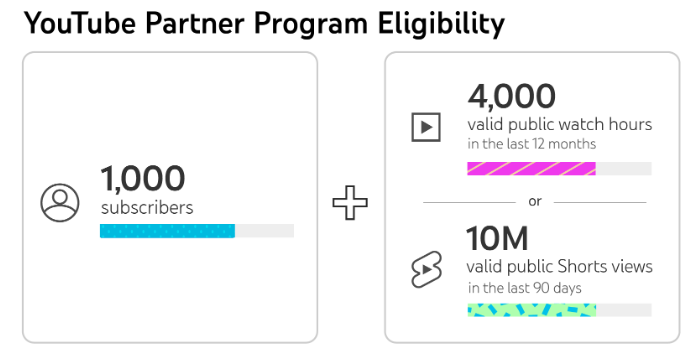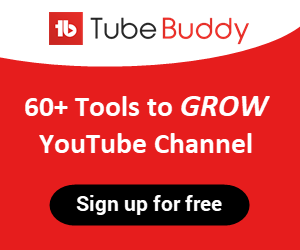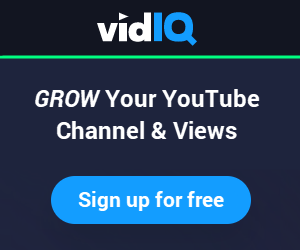August 23, 2024
Affiliate Disclosure: We may earn a commission if you buy something through the links on this page (at no extra cost).
In 2010, Daniel Middleton (DanTDM) created a YouTube channel and presumably didn’t earn much money as a teenager. However, a few years later, he would become one of the highest-paid YouTube stars. Many other YouTubers, including Jimmy Donaldson (Mr. Beast), Ryan Kaji (Ryan’s World), and Lilly Singh (Superwoman), also make millions annually.
Suffice it to say that uploading videos to YouTube can be an excellent way to earn a living. In this post, we’ll cover how to upload videos on YouTube to make money.
How to Upload and Publish Videos to YouTube
Uploading and publishing videos to YouTube is like the process for other social media websites. It requires a few clicks or taps, and here are the official steps.
On computer or desktop:
- Sign in to YouTube Studio.
- In the top-right corner, click Create.
- Select the file you want to upload.
- Navigate the prompts, add your video details, and click Publish.
On Google Android:
- Tap the plus icon, then Upload a video (or Create a Short).
- Grant YouTube access to your phone and files.
- Select an existing video from your gallery.
- If your video is 60 seconds or less and has a square or vertical aspect ratio, it will be uploaded as a Short. Shorts can be 15 or 60 seconds long, and you can add sound, text, and filters.
- Tap Next.
- Add your video details and tap Next.
- Navigate the prompts concerning audience and age appropriateness.
- Tap Upload to publish your video.
Follow the same steps to upload on other mobile devices, including Apple’s iPhone and iPad.
How to Earn Money on YouTube by Uploading Videos
Millions of people earn money on YouTube because it’s a high-traffic platform. It’s the second most visited website and search engine globally after Google. (Alphabet is the parent company of YouTube and Google.) That produces billions in advertising revenue for YouTube, with significant sums paid to creators.
YouTubers take different approaches to profiting from their channels and videos. One standard method is enrolling in YouTube’s partner program, whereas other users focus on affiliate marketing.
To monetize your content, you must own all the necessary rights to commercially use all visuals and audio elements, whether they belong to you or someone else. In addition, YouTube provides guidelines for content you create and don’t create. Lastly, you can generate revenue directly on YouTube and offsite, for example, by directing viewers to buy products on your online store.
YouTube Partner Program (Ads)
Ad revenue is the most common way YouTubers make money. Ad revenue is managed through YouTube’s Partner Program (YPP) and paid through AdSense. The YPP lets creators monetize their content on YouTube. Users can earn money from their videos’ advertisements and YouTube Premium subscribers who watch their content.
To be eligible for YPP, a user must:
- Get 1,000 subscribers with 4,000 valid public watch hours in the last 12 months, or
- Get 1,000 subscribers with 10 million valid public Shorts views over the previous 90 days.

Users in eligible countries can apply to the expanded YouTube Partner when they:
- Get 500 subscribers with three valid public uploads in the last 90 days and 3,000 valid public watch hours in the previous 12 months or
- Get 500 subscribers with three valid public uploads in the last 90 days and 3 million valid public Short views during the previous 90 days.
YouTube will then review your channel to ensure it follows its monetization policies. Finally, YouTube will email you when you’re eligible to apply. Users can leave YPP anytime by turning off the monetization feature on their dashboards.
How to join YouTube’s Partner Program:
- Sign in to YouTube.
- In the top right, select your account icon > YouTube Studio.
- In the left menu, scroll down and click on Monetization.
- Click on Apply Now.
- Follow the on-screen prompts and await more details from YouTube.
Once a channel joins YPP, the user must link it to an approved AdSense account. AdSense facilitates payments to content creators like YouTubers and bloggers once a month.
YouTube pays creators 55% of ad revenue; the details are in your YPP terms.
YouTube Shorts
YouTube Shorts is a way to connect with a new audience using a smartphone and the Shorts camera in the YouTube app. It follows the success of short videos on TikTok and Instagram, usually less than 60 seconds.
YouTube will pay creators 45% of ad revenue from their Shorts videos. However, YouTube hasn’t confirmed what will happen to its initial $100b fund for Shorts.
YouTube Super Chats
Super Chat allows viewers to purchase chat messages in live streams. Creators receive 70% of chat revenues. Revenue details are in the Commerce Product addendum.
YouTube Super Stickers
Super Stickers allow fans to purchase animated stickers during live streams and Premieres to show their favorite creators how much they enjoy their content. Stickers come in various designs across different languages and categories, such as gaming, fashion and beauty, sports, music, food, and more.
YouTube Super Thanks
YouTube viewers can now purchase Super Thanks (formerly Viewer Applause) to express their gratitude and show support. Also, they’ll see an animated GIF and get a distinct, colorful comment highlighting their purchase, which creators can engage.
Super Thanks is available at four price points between $2 and $50 (or the local currency equivalent). In addition, creators keep 70% of the viewer’s contribution.
YouTube Shopping Affiliate Program
YouTube Shopping is an integrated e-commerce feature on YouTube that enhances the shopping experience for viewers. Shoppable videos can feature tagged products that appear during playback, allowing viewers to click and purchase directly from the video. That provides a streamlined shopping experience for viewers and enhances the authenticity of product placements within organic content.
For content creators, YouTube Shopping offers a way to monetize their channels beyond traditional ad revenue. Creators can showcase products they genuinely use and endorse, often through brand partnerships, and include direct affiliate links to these products in their videos.
Brands benefit significantly from YouTube Shopping by accessing engaged audiences who trust their favorite creators’ recommendations. This form of marketing capitalizes on the persuasive power of influencer endorsements, driving higher conversion rates than traditional advertising methods.
YouTube Shopping’s eligibility requirements include the following:
- Your channel is in the YouTube Partner Program.
- Your channel must have more than 10,000 subscribers.
- You reside in the United States.
- Your channel is not a music channel, an Official Artist Channel, or associated with music partners. Music partners may include music labels, distributors, publishers, or VEVO.
- Your channel audience isn’t set as Made for Kids, and your channel doesn’t have many videos for kids.
- Your channel doesn’t have any active Community Guideline strikes.
YouTube Channel Memberships
Channel memberships allow viewers to join and support your channel through monthly payments. Furthermore, subscribers get members-only perks like badges, emojis, and other goods you offer. Eligibility requirements include:
- Your channel must have more than 1,000 subscribers.
- Your channel is in the YouTube Partner Program.
- You’re over 18 years old.
- You’re in one of the available locations.
- Your channel is not set to “made for kids.”
- You don’t have a significant number of ineligible videos.
- Videos set as made for kids or videos with music claims are considered ineligible.
- You (and your MCN) comply with YouTube’s terms and policies.
YouTube Select
YouTube Select is a premium advertising program aggregating top YouTubers and content for users between 18 and 49. Unlike YPP, creators cannot apply to YouTube Select, which is invitation-only. The revenue share for Select is secret since creators can negotiate better revenue splits. High-viewership channels like IGN, The Verge, SciShow, and itsJudysLife participate in YouTube Select.
YouTube BrandConnect
YouTube BrandConnect is a monetization service that connects creators with brands for branded content campaigns. It helps you get paid to include advertiser content in your videos and provides campaign management resources. You always retain creative control and choose your partnerships.
Product and Merchandise Sales
Many YouTubers leverage their channels to sell branded products and merchandise, including apparel, accessories, and gifts. With Shopify software, setting up an online store is quick and painless (Shopify has an exclusive partnership with YouTube to support sales).
Digital Media Sales
Many YouTubers sell online courses and books. Online courses are a natural extension because they include videos. For example, I’ve seen several travel vloggers with classes on travel tips and insights.
You can sell classes on e-learning marketplaces like Skillshare and Udemy or independently with course software like Thinkific.
Writing and publishing a book requires significant effort. Therefore, I recommend it only if you have thousands of subscribers or a significant audience/email marketing list to promote your book. For example, DanTDM wrote Trayaurus and the Enchanted Crystal, and Amy Landino published Vlog Like a Boss.
You can self-publish a book on Amazon KDP or publish it through a traditional publisher.
Grow Your YouTube Channel with VidIQ
Memberships and Subscriptions
A fantastic way to generate passive income is through membership and subscription payments. Patreon is a popular membership platform that allows artists and creators to collect and process subscription fees. Fans pay creators subscription amounts of their choice in exchange for exclusive experiences and behind-the-scenes content.
Patreon is growing as demonetization, stricter/unfair policies, and foul-ups by YouTube continue to upset YouTubers. It has three pricing plans. Alternatively, you might use a WordPress membership plugin, Shopify, or charge members in a closed/private Facebook Group. Additionally, many billing apps are available to support recurring payments.
Affiliate Marketing
Affiliate marketing is a performance-based advertising model. An affiliate (publisher) promotes a product/service online and receives compensation for achieving a specific objective or action. A merchant (advertiser) specifies the goal, usually a valid sale. For example, a merchant will pay an affiliate a 30% sales commission. A merchant may use one or multiple advertising pricing models, for instance, cost-per-action/acquisition (CPA), cost per sale (CPS), cost per lead (CPL), or pay-per-lead (PPL).
YouTubers who dabble in affiliate marketing add affiliate links to their descriptions and about sections. Creators will casually mention to “see” or “click” on links in their descriptions. They might also direct traffic to their websites for affiliate marketing and ecommerce purposes. Most affiliates on YouTube don’t disclose their affiliate links, but they should do so per the FTC’s guidelines.
Regarding your niche, you’ll find affiliate programs to complement your content. First, many affiliate networks have over 30 product/service categories. Explore my affiliate marketing content for different niches, such as gaming, cryptos, and travel. Secondly, many YouTubers promote TubeBuddy and VidIQ, two excellent channel management and growth apps with high-paying affiliate programs.
More great reads:
- 19 Best Tools for YouTubers
- 17 Best AI Tools for YouTube Creators
- 6 Best YouTube Tag Generators
- TubeBuddy Plans and Pricing
Paid Product Placements
Like product placements in movies and endorsements by professional athletes, YouTubers can also earn money in these ways. According to YouTube,
You may include paid product placements, endorsements, sponsorships, or other content that requires disclosure to viewers in your videos. If you choose to include any of the above, you must inform us by selecting the paid promotion box in your video details.
Paid product placements are content created for a third party in exchange for compensation or where that third party’s brand, message, or product is integrated directly into the creator’s material.
Endorsements are content created for an advertiser or marketer that contains a message whereby consumers are likely to believe the content creator or endorser’s opinions, beliefs, or experiences.
In most cases, companies often approach high-traffic YouTubers to promote and endorse products. However, some creators initiate and pursue deals.
Content Partnerships
YouTubers with significant and loyal followings—those usually in the YouTube Select category—are ripe for original programming deals with YouTube Premium, Netflix, Amazon, and other media platforms. For example, YouTube star Casey Neistat inked a $25 million partnership with CNN. In addition, Brazilian vlogger and comedian Felipe Neto released an original Netflix comedy special, “My Life Makes No Sense.”
Live Events
A lesser-known revenue stream for YouTubers is live events such as tours, speaking engagements, concerts, premium webinars, and comedy gigs. For instance, DanTDM toured Australia.
Eventbrite and Ticketmaster can help with ticket administration, marketing, and sales.
Crowdfunding
Crowdfunding is a fundraising strategy that focuses on raising smaller amounts of money from a collective of individuals. YouTube is an excellent marketing channel for promoting crowdfunding campaigns. Kickstarter, Indiegogo, and GoFundMe are only a few crowdfunding sites.
Start Earning
Success on YouTube and a person’s earning potential depend on their status. Professional YouTubers are highly active and engaged on the platform and dedicate most of their working hours to creating and promoting their content. Conversely, casual content creators upload videos infrequently, and YouTube isn’t their primary focus or revenue stream. Whichever category you belong to, there are multiple ways to make money on YouTube. Create excellent content, and the revenue will follow.
Frequently Asked Questions
How much can you make on YouTube?
There are no limits to how much a YouTuber can earn, which differs from most jobs. However, some video categories perform better than others. For example, comedy/skits, gaming, fashion, music, and tech are high-revenue potential categories.
Billions of people flock to YouTube to be entertained and relax. As a result, engaging videos and high production value can yield significant revenues regardless of the content category. For instance, geography isn’t an exciting topic for most people. However, Paul Barbato infuses his geography-themed videos with flair, excitement, and comedy. As a result, his channel has amassed millions of views and subscribers.
How much does YouTube pay you for 1 million views?
If creators don’t enroll in YouTube monetization activities like YPP, they will earn nothing from their views. However, if the creator enables monetization with ads, 1 million views can generate between two and five thousand dollars for the creator. The AdSense revenue that a creator earns will vary depending on many factors, including the ad types, ads running, the number of ads, average ad consumption, content category, and average video length.
How many subscribers do you need to get paid?
Channel subscribers don’t factor into AdSense revenue; they only enable YouTube monetization features. However, channels that feature many subscribers have an advantage in social proof. Social proof is a psychological phenomenon in which people rely on the feedback and actions of others to determine what is right and wrong in each situation. Therefore, if an individual sees many channel subscribers, it will motivate them to subscribe.
How do you earn money from YouTube without AdSense?
YouTubers can earn money without AdSense through ecommerce, affiliate marketing, paid product placements and endorsements, membership fees, live events, and other sources.
Do you earn money on YouTube Premium?
All your videos on ad-supported YouTube will also be available without ads on YouTube Premium, providing a secondary revenue stream for creators through AdSense.
How does YouTube pay?
YouTube pays publishers through AdSense, and depending on your payment address, the following payment options may be available:
- Check
- Electronic Funds Transfer (EFT)
- EFT via Single Euro Payments Area (SEPA)
- Wire Transfer
- Western Union Quick Cash
How does YouTube handle taxes on creators’ earnings?
Google is required to collect tax info from creators in the YouTube Partner Program. If any tax deductions apply, Google will withhold taxes on YouTube earnings from viewers in the U.S. from ad views, YouTube Premium, Super Chat, Super Stickers, and Channel Memberships. Learn more here.

